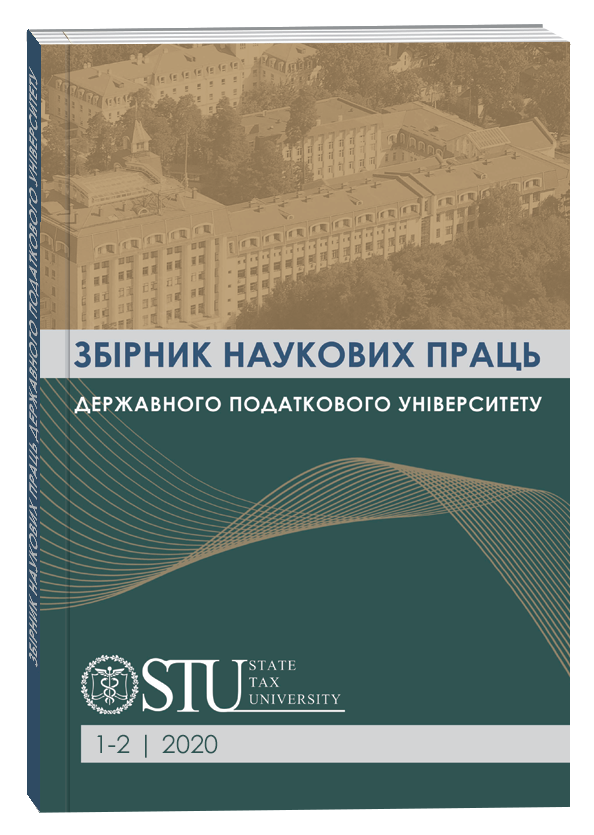RESEARCH OF DEVELOPMENT FINTECH: CASE FOR EASTERN EUROPEAN COUNTRIES
DOI:
https://doi.org/10.33244/2617-5940.1-2.2020.8-25Keywords:
Bank, Insurance Company, Investment Fund, FinTech Company, Financial Services MarketAbstract
Within the article, strategic importance of the FinTech development in Ukraine based on Eastern Europe's FinTech market indicators is identified. Elements of the financial institutions, which ensure proper functioning of the market, are considered, and distinctive features of the native FinTech landscape are determined. The main motives and directions of state regulation of the investigated sphere in the financial services market are presented. Types of FinTech companies by sector in Ukraine are analyzed. Due to the multi-factor econometric modeling, some factors (GDP, population size, consumer spending, and Internet access), which determine the development level of FinTech in Hungary, Poland, Slovakia, Romania and Ukraine, are identified. Based on the conducted SWOT analysis, opportunities and threats, weaknesses and strengths of the functioning and development of these services in Ukraine are identified. On the grounds of the identified trends and taking into consideration the experience of foreign countries, priority directions and tools for its development in Ukraine are proposed, the priority of which are: technical support of the FinTech market functioning; modernization of FinTech business models in the direction of the technology development and customer needs, partnerships and cooperation with banking institutions; digitization of banking functions and payments, use of own databases; use of services of your own IT companies or software of well-known international suppliers such as SAP; overcoming the problem of the financial services market development in Ukraine due to low mentality, confidence and lack of financial literacy on the basis of building the institute of trust; formation of the favorable investment climate for the financial assets inflow for the FinTech development on the basis of the state support introduction for the investment activity by means of tax incentives.
References
Andriushchenko K., Ishchenko M., Sahaidak M., Tepliuk M., & Domina O. Prerequisites for the creation of financial and credit infrastructure of support for agricultural enterprises in Ukraine. Banks and Bank Systems. 2019. 14(2). Р. 63-75.
Abramova A., Beschastnyy V., Zhavoronok A., Fedyshyn M., Lavrov R., Dluhopolskyi O., & Kozlovskyi S. Financial technologies development prospects in the countries of Eastern Europe and Ukraine. International Journal of Management (IJM). 2020. 11(7). P. 384-398.
Azarenkova G., Shkodina I., Samorodov B., Babenko M., & Onishchenko I. The influence of financial technologies on the global financial system stability. Investment Management and Financial Innovations. 2018. 15(4). Р. 229-238.
Каталог FinTech компаній України. URL: http://drive.fintechua.org/FintechCatalog19Ukr.pdf
Cosmulese C.G., Grosu V., Hlaciuc E., & Zhavoronok A. The Influences of the Digital Revolution on the Educational System of the EU Countries. Marketing and Management of Innovations. 2019. 3. Р. 242-254.
Chernadchuk V., Sukhonos V., & Shkolnyk I. The notion and content of financial system in the context of financial law of Ukraine. Problems and Perspectives in Management. 2017. 15(2-1). Р. 234-245.
Chmutova I., Vovk V., & Bezrodna O. Analytical tools to implement integrated bank financial management technologies. Economic Annals-XXI. 2017. 163(1-2(1)). Р. 95-99.
Fedyshyn M.F., Abramova A.S., Zhavoronok A.V., & Marych M.G. Management of competitiveness of the banking services. Financial and credit activity: problems of theory and practice. 2019. Vol. 1 (28). Р. 64-74.
Fedyshyn M.F., Marich M.G., & Abramova A.S. The influence of credit factors on the development of the real economic sector in the conditions of economic. Financial and credit activity: problems of theory and practice. 2018. 2(25). Р. 366-374.
Fernandez-Vazquez S., Rosillo R., Fuente D., & Priore P. Blockchain in FinTech: A Mapping Study. Sustainability. 2019. 1(22). Р. 63-66.
Gilster P. Digital literacy. 1997. New York: Wiley Computer Publications.
Ivashchenko A., Britchenko I., Dyba M., Polishchuk Ye., Sybirianska Yu., & Vasylyshen Yu. Fintech platforms in SME’s financing: EU experience and ways of their application in Ukraine. Investment Management and Financial Innovations. 2018. 15(3). Р. 83-96.
Kholiavko N., Djakona A., Dubyna M., Zhavoronok A., & Lavrov R. The higher education adaptability to the digital economy. Bulletin of the National Academy of sciences of the Republic of Kazakhstan. 2020. 4. 386. P. 294-306.
Kholiavko N., Zhavoronok A., Marych M., Viknianska A., Kozlovskyi S., & Herasymiuk K. Countries disposition in the global scientific and educational area: management and clustering. International Journal of Management (IJM). 2020. 11(5). P. 400-415.
Kosach I.A., Zhavoronok A.V., Fedyshyn M.F., & Abramova A.S. Role of commission receipts in formation of the revenue of the commercial bank. Financial and credit activity: problems of theory and practice. 2019. 4 (31). Р. 22-30.
Laktionova A., & Zhytar M. (2013). Institutional flexibility of decision making as a basis for a bank’s investment strategy selection. Economic Annals-XXI. 2013. 5-6(1). Р. 49-52.
Lavrov R., Beschastnyi V., Nikolenko L., Yousuf A., Kozlovskyi S., & Sadchykova I. Special aspects of the banking institutions rating: a case for Ukraine. Banks and Bank Systems. 2019. 14(3). Р. 48-63.
Mints O., Marhasova V., Hlukha H., Kurok R., & Kolodizieva T. Analysis of the stability factors of Ukrainian banks during the 2014-2017 systemic crisis using the Kohonen self-organizing neural networks. Banks and Bank Systems. 2019. 14(3) Р. 86-98.
Офіційний сайт «Statista». URL: https://www.statista.com
Shkarlet S., & Dubyna M. Features of the cognitive approach application to the essence of the financial services market identification. Economic Annals-XXI. 2016. 158(3-4(2)). Р. 70-74.
Shkarlet S., Dubyna M., Shtyrkhun K., & Verbivska L. Transformation of the Paradigm of the Economic Entities Development in Digital Economy. WSEAS Transactions on Environment and Development. 2020. 16. Р. 413-422.
Shkarlet S., Dubyna M., Vovk V., & Noga M. Financial service markets of Eastern Europe: a compositional model. Economic Annals-XXI. 2019. 176(3-4). Р. 26-37.
Zveryakov M., Kovalenko V., Sheludko S., & Sharah E. (2019). FinTech sector and banking business: competition or symbiosis? Economic Annals-XXI. 2019. 175(1-2). Р. 53-57.
Andriushchenko, K., Ishchenko, M., Sahaidak, M., Tepliuk, M., & Domina, O. (2019). Prerequisites for the creation of financial and credit infrastructure of support for agricultural enterprises in Ukraine. Banks and Bank Systems, 14(2), 63-75.
Abramova, A., Beschastnyy, V., Zhavoronok, A., Fedyshyn, M., Lavrov, R., Dluhopolskyi, O. & Kozlovskyi S. (2020). Financial technologies development prospects in the countries of Eastern Europe and Ukraine. International Journal of Management (IJM), 11(7), 384-398.
Azarenkova, G., Shkodina, I., Samorodov, B., Babenko, M., & Onishchenko, I. (2018). The influence of financial technologies on the global financial system stability. Investment Management and Financial Innovations, 15(4), 229-238.
Catalog of FinTech companies in Ukraine. Retrived from https://drive.fintechua.org/FintechCatalog19Ukr.pdf
Cosmulese, C.G., Grosu, V., Hlaciuc, E., & Zhavoronok, A. (2019). The Influences of the Digital Revolution on the Educational System of the EU Countries. Marketing and Management of Innovations, 3, 242-254.
Chernadchuk, V., Sukhonos, V., & Shkolnyk, I. (2017). The notion and content of financial system in the context of financial law of Ukraine. Problems and Perspectives in Management, 15(2-1), 234-245.
Chmutova, I., Vovk, V., & Bezrodna, O. (2017). Analytical tools to implement integrated bank financial management technologies. Economic Annals-XXI, 163(1-2(1)), 95-99.
Fedyshyn, M.F., Abramova, A.S., Zhavoronok, A.V., & Marych, M.G. (2019). Management of competitiveness of the banking services. Financial and credit activity: problems of theory and practice, Vol. 1 (28), 64-74.
Fedyshyn, M.F., Marich, M.G., & Abramova, A.S. (2018). The influence of credit factors on the development of the real economic sector in the conditions of economic. Financial and credit activity: problems of theory and practice, 2(25), 366-374.
Fernandez-Vazquez, S., Rosillo, R., Fuente, D., & Priore, P. (2019). Blockchain in FinTech: A Mapping Study. Sustainability, 1(22), 63-66.
Gilster, P. (1997). Digital literacy. New York: Wiley Computer Publications.
Ivashchenko, A., Britchenko, I., Dyba, M., Polishchuk, Ye., Sybirianska, Yu., & Vasylyshen, Yu. (2018). Fintech platforms in SME’s financing: EU experience and ways of their application in Ukraine. Investment Management and Financial Innovations, 15(3), 83-96.
Kholiavko, N., Djakona, A., Dubyna, M., Zhavoronok, A., & Lavrov, R. (2020). The higher education adaptability to the digital economy. Bulletin of the National Academy of sciences of the Republic of Kazakhstan, 4, 386, 294-306.
Kholiavko, N., Zhavoronok, A., Marych, M., Viknianska, A., Kozlovskyi, S. & Herasymiuk, K. (2020). Countries disposition in the global scientific and educational area: management and clustering. International Journal of Management (IJM),11(5), 400-415.
Kosach, I.A., Zhavoronok, A.V., Fedyshyn, M.F., & Abramova, A.S. (2019). Role of commission receipts in formation of the revenue of the commercial bank. Financial and credit activity: problems of theory and practice, 4 (31), 22-30.
Laktionova, A., & Zhytar, M. (2013). Institutional flexibility of decision making as a basis for a bank’s investment strategy selection. Economic Annals-XXI, 5-6(1), 49-52.
Lavrov, R., Beschastnyi, V., Nikolenko, L., Yousuf, A., Kozlovskyi, S., & Sadchykova, I. (2019). Special aspects of the banking institutions rating: a case for Ukraine. Banks and Bank Systems, 14(3), 48-63.
Mints, O., Marhasova, V., Hlukha, H., Kurok, R., & Kolodizieva, T. (2019). Analysis of the stability factors of Ukrainian banks during the 2014-2017 systemic crisis using the Kohonen self-organizing neural networks. Banks and Bank Systems, 14(3), 86-98.
Official site of the Statista. Retrived from https://www.statista.com
Shkarlet, S., & Dubyna, M. (2016). Features of the cognitive approach application to the essence of the financial services market identification. Economic Annals-XXI, 158(3-4(2)), 70-74.
Shkarlet, S., Dubyna, M., Shtyrkhun, K., & Verbivska, L. (2020). Transformation of the Paradigm of the Economic Entities Development in Digital Economy. WSEAS Transactions on Environment and Development, 16, 413-422.
Shkarlet, S., Dubyna, M., Vovk, V., & Noga, M. (2019). Financial service markets of Eastern Europe: a compositional model. Economic Annals-XXI, 176(3-4), 26-37.
Zveryakov, M., Kovalenko, V., Sheludko, S., & Sharah, E. (2019). FinTech sector and banking business: competition or symbiosis? Economic Annals-XXI, 175(1-2), 53-57.



